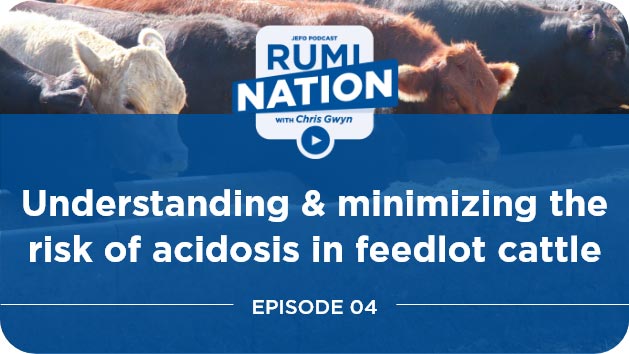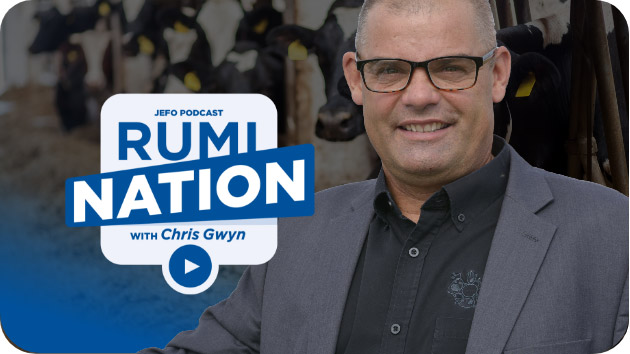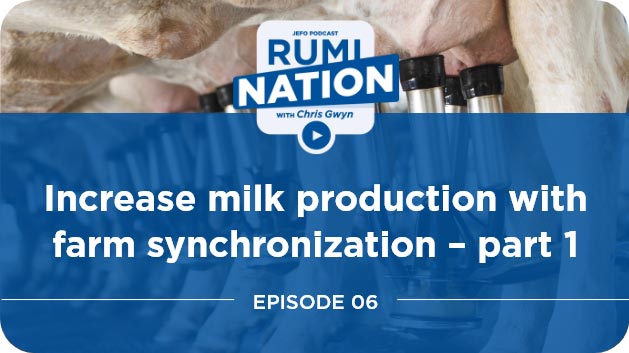RumiNation | S02 : E05
Best Feeding Management
Practices for Receiving Cattle
Brought to you by Jefo Nutrition
Share now!
Did you enjoy this episode?
Share now!
Best Feeding Management Practices for Receiving Cattle
What should we feed newly received cattle in the first few weeks? What are the best strategies and management practices for producers? What should we address first, health or performance?
Get answers and more with expert Dr. Erickson.
Our guest - Dr. Galen Erickson
Dr. Galen Erickson has been teaching, researching and supporting the feedlot industry for the last 20 years. Since 2012, he holds the title of Nebraska Cattle Industry Professor of Animal Science at the University of Nebraska. His areas of expertise are beef cattle, extension, and ruminant nutrition.

Timestamps & Summary
01:06:00 – At the annual Jefo Beef Academy, you presented the best nutritional management practices related to receiving cattle. Could you summarize the key nutritional considerations?
The first step is to classify cattle into risk categories. Then, we need to make sure they know how to eat.
Some calves may already be hungry because of transportation, so it’s better not to give them too much grain on the first days to avoid overeating.
Also, there’s good evidence that calves that have more health concerns benefit from a diet with more forage, even if it limits some of their growth. It’s a balance between health and growth we need to find.
04:25:00 – What do you recommend a producer on how to meet that balance?
A good starting point is to give the cattle a diet composed of about 35% to 45% of high-quality forage.
For the 2/3 of the diet remaining, Dr. Erickson recommends giving wet by-products such as wet distillers grain, and wet corn gluten feed. The main benefits are that they:
1. Are fibrous (which limits the risk of acidosis);
2. Add moisture (which helps cut down dust, and holds the diet together);
3. Are extremely palatable.
For the little left in the diet, he recommends dry rolled corn, barley, or your grain sources.
What you want to do is limit corn silage and other fermented silage. Also, it’s better to limit high-moisture corn and high-moisture grains. If you know the cattle are hungry, you can feed them some hay on arrival. After a few weeks, when the health outcomes are improving, you can start increasing energy content to get a better performance.
07:33:00 – What are people doing differently regarding the length of the receiving period?
If the cattle don’t seem well enough, producers should be patient and not shorten the receiving period much below a few weeks. It’s better to get them healthy, and then worry about the best performance on them.
If they are at a low risk, you can shorten the receiving period to less than a week.
8:50:00 – Are there other key points that producers should be reminding themselves of?
If you have access to pasture, we have good evidence that getting the cattle in it cut health concerns by half (from 53% to 23%). But the key is really to get the base diets right first, and then worry about additives that could fortify it.
Be sure to base your choice of additives on data and science, as there are a lot of products and nutritional recommendations out there.
11:32:00 – Were you able to look at the cattle having a pasture access right through finish? How did they do?
This is a challenge with research. In some cases, they did not follow those through.
Sometimes, it only helps in the short term. For example, Dr. Erickson did a study with feed additives at receiving. Even though they improved the health outcomes at the beginning, the calves finished the same.
A great question producers can ask themselves is: What will be the carry-over effects of anything they do in that first few weeks?
12:53:00 – Do you think that having more access to feed all the time for those calves played a role in your pasture study?
Perhaps it did, but it could be because they were spread out, or the fact that they were used to grazing and we put them back into a grazing situation.
Regarding bunk space, a key consideration for producers who bring in cattle is to limit feeding the first weeks so you can make sure that all of them are eating at the time of feeding. Also, the first candidates to be checking out closer for health concerns will be the ones that don’t come up at the time of feeding.
15:10:00 – Do you have some take-home messages for the audience today?
Get your risk categories right based on your previous experiences, and if the cattle are at a low risk, you can be more aggressive on them. With higher-risk calves, pay a little more attention to forage in the diet. If you have challenges with health, consider feeding them more forage, and make sure that it’s high quality.
Get those diets right, and then start exploring feed additives. Be careful to choose them based on science and recommendations.







